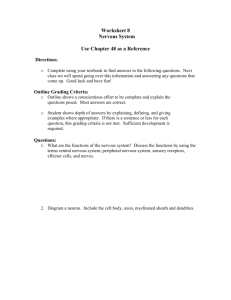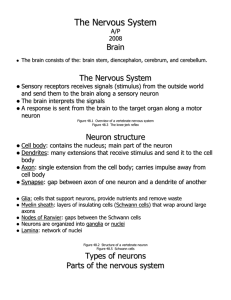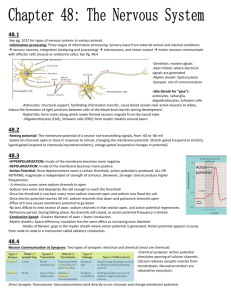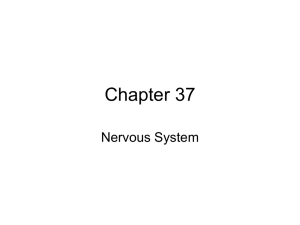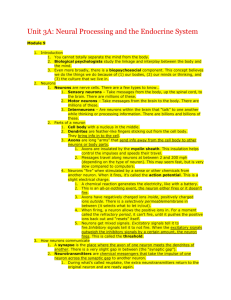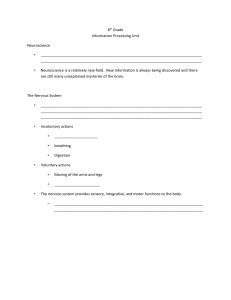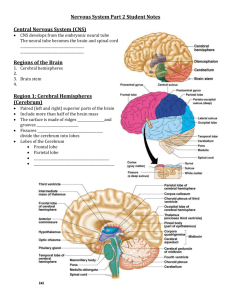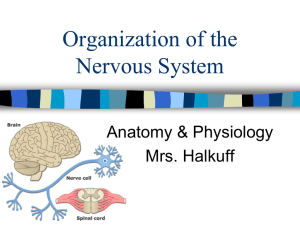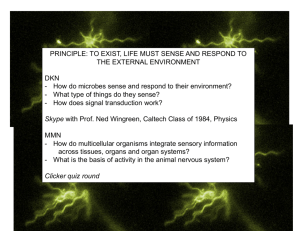THE NERVOUS SYSTEM AP BIOLOGY MS. VITALE THREE
advertisement
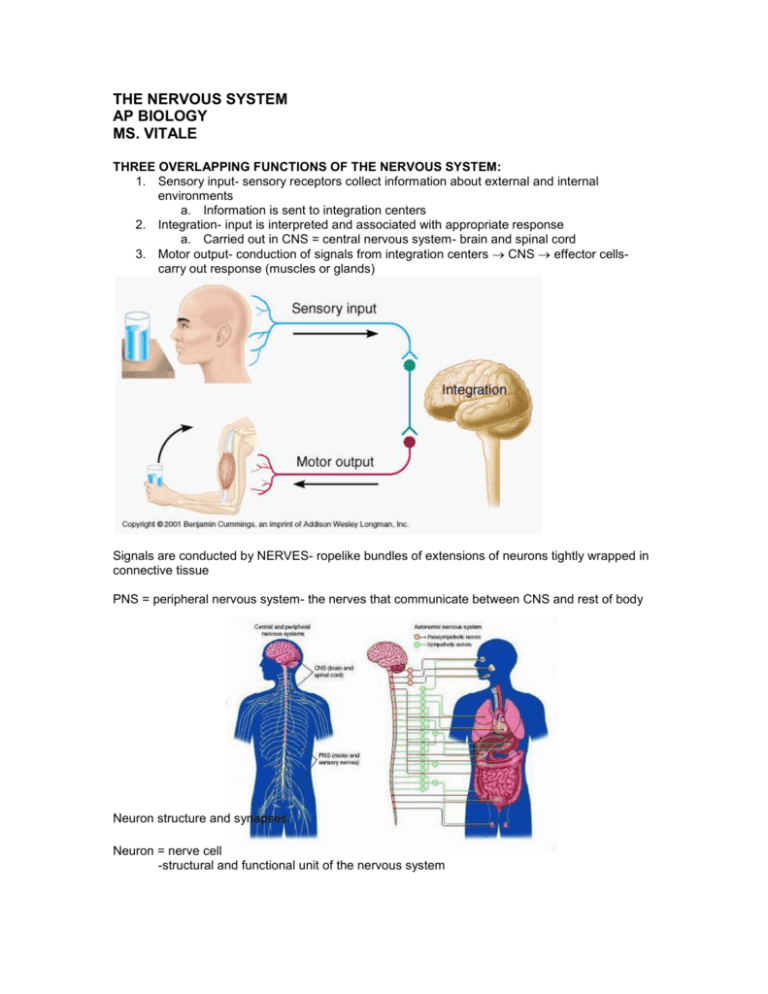
THE NERVOUS SYSTEM AP BIOLOGY MS. VITALE THREE OVERLAPPING FUNCTIONS OF THE NERVOUS SYSTEM: 1. Sensory input- sensory receptors collect information about external and internal environments a. Information is sent to integration centers 2. Integration- input is interpreted and associated with appropriate response a. Carried out in CNS = central nervous system- brain and spinal cord 3. Motor output- conduction of signals from integration centers CNS effector cellscarry out response (muscles or glands) Signals are conducted by NERVES- ropelike bundles of extensions of neurons tightly wrapped in connective tissue PNS = peripheral nervous system- the nerves that communicate between CNS and rest of body Neuron structure and synapses: Neuron = nerve cell -structural and functional unit of the nervous system Cell body- nucleus and other organelles Dendrites- short, highly branched processes o Receive information from other cells Axons- longer o Send messages out Axon hillock- where axon joins cell body Myelin sheath- insulating layer on axon Synaptic terminals- end of axon o Release neurotransmitters (chemical messages) Synapse- site where synaptic terminal contacts target cell (neuron or effector) Presynaptic cell- transmitting cell Postsynaptic cell- target cell Reflex- simplest type of nerve circuit Sensory neurons- receive information from receptor -information is passed to a motor neuron- which signals effector cell Interneurons- communicate with other neurons Ganglion- cluster of nerves in PNS Glia- supporting cells between neurons Schwann cells- glia that form myelin sheath Nodes of Ranvier- space between Schwann cells Only place on axon where signals can be transmitted Signals jump from node to nod, making it move faster then just traveling straight down MS = Multiple Sclerosis- immune system destroys myelin sheath Loss of signal conduction, muscle control and brain function Membrane potential- the different concentrations of ions inside and outside a cell Causes electrical charge difference Anions are more concentrated inside cell Cations are more concentrated outside cell Resting potential- the membrane potential of a neuron in resting state Not transmitting electrical signal Unstimulated The membrane of the neuron keeps large molecule (proteins) with a (-) charge in the cell The membrane also uses protein pumps to pass ions through While resting, K+ ions are not moved out, Na+ are moved out using sodium potassium pumps and other protein channels This creates a (-) charge inside the cell and a (+) charge outside the cell stimulus- causes a nerve signal to be generated action potential- a nerve signal Changes in the membrane potential can result in an electrical impulse Neurons have gated ion channels- that open and close in response to a stimulus The ion concentration changes therefore the membrane potential changes Different types of ion channels respond to chemicals (neurotransmitters) or voltage (change in membrane potential) threshold potential- the minimum change in a membrane’s voltage that must occur to generate a nerve signal (action potential) Once the threshold potential is reached, a nerve signal is triggered Quckly, the inside of the cell becomes more (+) the the outside The membrane quickly repolarizes as the voltage drops back down, it goes below resting potential and then returns to resting potential The quick change of the membrane potential is caused by quick movements of ions The action potential only occurs at one point on the neuron’s membrane- on the axon near the cell body Synapse- junction between 2 neurons or between a neuron and an effector cell Electrical synapses- action potentials directly from first to second cell Common in areas where steady contraction occur (ex: heart, GI tract) Gap junctions between first and second cell are channels that allow ions to flow from cell to cell Chemical synapses- synaptic cleft separates first and second cell, ions can’t be transmitted (ex: skeletal muscles) The cytoplasm at tip of first cell contains sacs called synaptic vesicles- contains thousands of molecules of neurotransmitters The action potential of the first cell cause synaptic vesicles to fuse with the plasma membrane, releasing their neurotransmitters into synaptic cleft (exocytosis) The neurotransmitters bind to receptor molecules on second cell Ion channels open, ions diffuse into second cell, creating a new action potential Enzymes break down the neurotransmitters, closing the ion channels Caffeine reverses inhibiting neurotransmitters Nicotine activates acetylcholine receptors Alcohol increases inhibitors TYPES OF NERVOUS SYSTEMS: Nerve net- simplest nervous system Web of neurons No brain Ex: hydra Cephalization- concentration of nervous system in head Centralization- presence of CNS and PNS Vertebrates are highly cephalized and centralized Spinal cord- receives information from PNS Brain- master control center Blood vessels in brain have a blood-brain barrier- very what goes in brain tissue Ventricles-space in center of brain Filled with fluid Drain into central canal of spinal cord selective as to Capillaries secrete cerebrospinal fluid which cushions CNS, supplies nutrients, hormone, and WBCs Meninges- connective tissue layers surround and protect brain and spinal cord Cerebrospinal fluid between 2 layers creates cushion White matter- outer part of spinal cord Mainly axons White due to myelin Gray matter- inside spinal cord Cell bodies and dendrites Crainal nerves- to and from brain Spinal nerves- to and from spinal cord Both are part of Peripheral Nervous System PERIPHERAL NERVOUS SYSTEM Sensory (afferent) division- incoming nerves o From sensory receptors of external and internal environment Motor (efferent) division- outgoing nerves CNS and effector cells o Somatic nervous system Carries signals to skeletal muscles in response to external stimuli Voluntary, conscious control o Autonomic nervous system Carries signals that regulate internal environment Muscles of cardiac, digestive, excretory, and endocrine systems Sympathetic division- arousal and energy generation Occurring during fight or flight and strenuous exercise Increase heart rate and respiration Liver converts glycogen to glucose Adrenaline is released Digestion slows Parasympathetic division- calming, maintenance, resting Decrease heart rate Increase in digestion Energy is stored from Three hollow bulges at anterior end of neural tube in embryo form the brain Forebrain- cerebrum is outgrowth of forebrain o Cerebrum evolved in complex vertebrates o Cerebrum is largest in virds and mammale Midbrain Hindbrain Brainstem- anterior of spinal cord Medulla oblongata o Contains centers that control visceral functions (breathing, heart rate, swallowing, digestion) Pons o Also controls visceral activities Midbrain o Auditory data o Visual reflexes o Sends sensory data to higher brain centers Sleep and arousal are controlled by several centers in the brainstem and cerebrum EEG- electroencephalogram - measures brain waves (electrical activity of brain) Cerebellum- coordination and error checking during motor, cognitive performances - learning and remembering - eye-hand coordination Thalamus- main input center for sensory information going to cerebrum and main output center for information leaving cerebrum - sorts incoming information and sends to appropriate higher centers - receives information that regulates emotion and arousal perceptual, and brain Hypothalamus- regulates homeostasis - makes 2 hormones o posterior pituitary and releasing hormones o contains thermostat o regulates hunger, thirst, basic survival mechanisms o sex and mating behavior o flight or fight o pleasure Rhythmic behavior (daily rhythms) When we eat, sleep, peak Circadian rhythm 24 hour cycle persists even in absence of external clues strong internal component called biological clock o SCN = suprachiasmatic nuclei In mammals biological clock in hypothalamus Pair of structures whose cells produce proteins in response to dark and light Cerebrum-most highly evolved structure of mammalian brain - Divided into right and left hemispheres - Each hemisphere has an outer covering gray matter called the cerebral cortexo gray matter o largest and most complex part of brain o has evolved the most - Each hemisphere also has white matter basal nucleio A cluster of nuclei deep within white matter o Important for movement o Damage can cause Parkinson’s or Huntington’s disease - Neocortex- of the and o o o o o Additional outer layer of cortex Only in mammals Associated with greater cognitive abilities and more sophisticated behavior Relative to size and presence of convolutions which increase surface area Human neocortex = .5m 2 surface area = 80% total brain mass Porpoise is 2nd largest Left cerebral cortex is responsible for right side of body and visa-versa Corpus callosum- thick band of fibers communicates between right and left sides Cerebral cortex has 4 lobes: Motor cortex- sends commands to skeletal muscles Somatosensory cortex- touch, pain, pressure, temperature Language and speech- Broca’ s areas for speaking, in frontal lobe of motor cortex - Wernicke’s area for speech comprehension, in posterior of temporal lobe Limbic system- ring around brainstem - Sections of thalamus and hypothalamus with hippocampus and olfactory cortex - Central to behavior o Ex: nurturing of infants and bonding which distinguishes mammals from other animals o Laughing and crying o Feelings Memory and learning- Short-term memory in frontal lobe - Long-term memory in hippocampus Consciousness- experiencing ourselves as sensing, acting, feeling, and thinking about the past and the future - How many of these capabilities extend to other animals is a big debate

